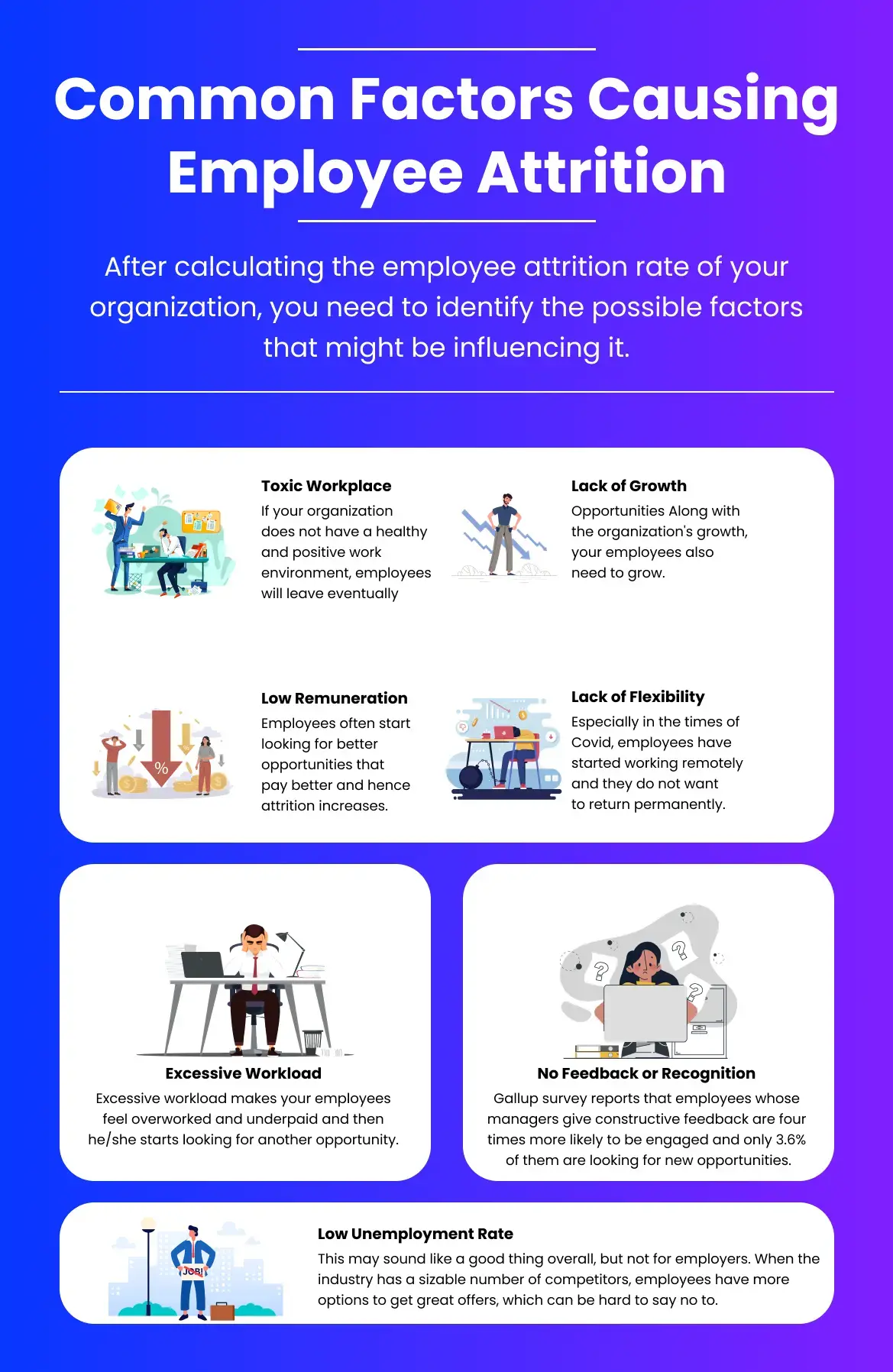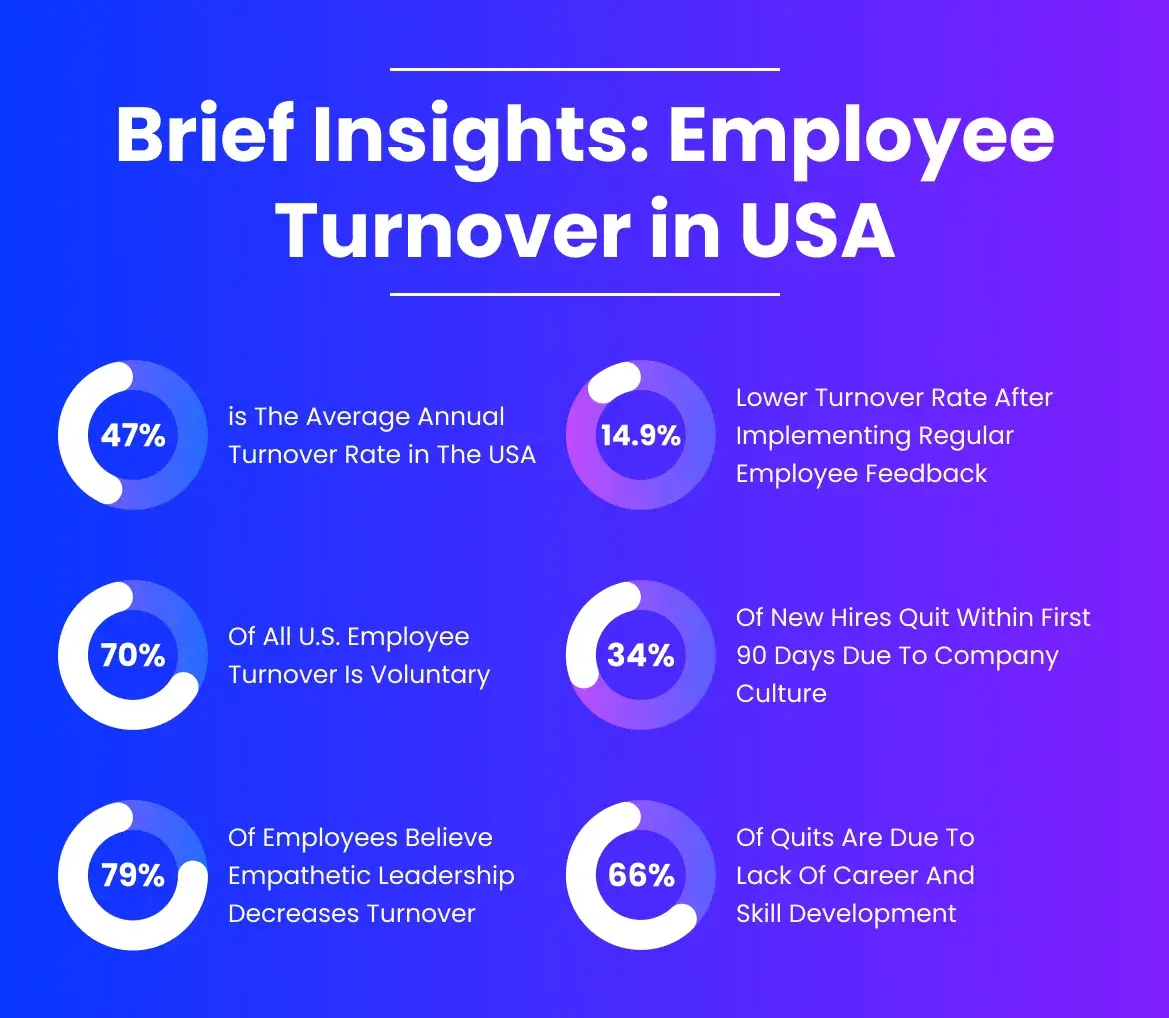Table of content
Attrition isn’t just about employees leaving; it’s about the tremors it sends through a company. In HR tech, each departure has a ripple effect. It’s not just about filling a position; it’s about the team left behind, the culture affected, and the knowledge lost. It’s a dynamic that directly shapes how a company operates.
In this blog, we delve into the intricacies of unregretted attrition, deciphering its nuances and shedding light on its pivotal role within the broader context of attrition in the HR tech industry.
Unregretted Attrition
Attrition is the departure of employees from a company. It’s a natural part of any workforce, influenced by various factors such as career growth, work environment, or personal reasons. Understanding attrition involves recognizing its impact on teams, culture, and productivity.
On the other hand, unregretted attrition isn’t about mere departures; it’s about departures that companies don’t view as losses but rather as opportunities. These exits often involve employees whose departure can create space for fresh perspectives or skill sets that align better with the company’s future goals.
Differentiating Regretted vs. Unregretted Attrition
Regretted attrition involves losing key personnel or skills that significantly impact operations. In contrast, unregretted attrition is about departures that, while noticed, don’t hinder organizational progress and might even open doors to new possibilities.
The Significance of Identifying Unregretted Attrition
Recognizing unregretted attrition is pivotal. It allows organizations to differentiate between departures that are detrimental and those that can drive positive change. Identifying these departures strategically enables companies to adapt and realign resources effectively, fostering an environment of growth amidst transitions.
Analyzing Attrition Rate
Assessing attrition involves understanding key metrics like overall turnover rate, voluntary and involuntary attrition, and tenure-based attrition. These metrics help gauge the extent and nature of departures within an organization.
Factors Influencing Attrition in the Tech Industry
In the tech industry, attrition is influenced by several factors including career growth opportunities, work-life balance, company culture, competitive salaries, and technological advancements. Understanding these factors is crucial to mitigate unnecessary departures.
How to Gather Reliable Insights
Gathering reliable data involves using various methods like exit interviews, employee surveys, performance reviews, and HR analytics tools. Accurate data collection aids in understanding the reasons behind attrition and forming actionable strategies.
Identifying Patterns and Trends in Attrition
Analyzing collected data helps identify patterns and trends in attrition. This analysis uncovers recurring reasons for departures, seasonal trends, or department-specific attrition, enabling HR professionals to proactively address issues and implement targeted retention strategies.
Measuring and Evaluating Attrition Rate
Calculating attrition rate involves simple formulas like dividing the number of employees who left by the average number of employees and multiplying by 100. Different methods might be used based on specific organizational needs for a comprehensive understanding.
ATTRITION RATE (%)= (Number of employees left/number of employees)*100
Utilizing Technology for Accurate Measurement
Leveraging technology, such as HR analytics software, aids in accurate and real-time measurement of employee turnover & attrition rates. These tools provide insights, trends, and predictive analytics, enhancing the precision of attrition rate calculations.
Assessing the Impact of Attrition on Organizational Dynamics
Understanding how attrition affects organizational dynamics is crucial. It impacts team morale, productivity, knowledge transfer, and even client relationships. Evaluating these effects helps in devising strategies to minimize negative impacts.
Strategies for Mitigating Unregretted Attrition
To mitigate unregretted attrition, companies can focus on strategies like career development programs, fostering a positive work environment, offering competitive benefits, and implementing effective succession planning. These strategies aim to retain valuable employees while embracing departures that lead
to positive change.
Employee Attrition vs. Employee Turnover
In the landscape of human resources, the terms “employee attrition” and “employee turnover” might seem interchangeable, but they carry nuanced differences that impact how businesses perceive and manage workforce transitions.
Employee Attrition
This term encapsulates the natural ebb and flow of employees departing from an organization over time. Attrition covers various reasons for departures, from employees opting for new opportunities, retiring, or even unforeseen events altering their career paths. It’s a broader lens that doesn’t solely focus on replacement but acknowledges the gradual decrease in workforce numbers.
Employee Turnover
Conversely, turnover zooms in on the rate at which employees leave and are replaced within a specific period. It zeroes in on the cyclical aspect of employees exiting and new ones entering the organization. Often used as a metric, turnover measurement gauges the frequency of employee departures and their subsequent replacements.
While both concepts revolve around employee departures, their distinction lies in perspective. Attrition offers a panoramic view of various exit reasons, while turnover is more quantitative, spotlighting the replacement rate within a defined timeframe.
Understanding these distinctions is pivotal for organizations seeking to manage workforce transitions effectively. Recognizing the reasons behind exit helps shape strategic initiatives aimed at talent retention and recruitment, ultimately contributing to a more resilient and stable organizational workforce.
Conclusion
In the intricate landscape of HR tech, attrition emerges not just as a numerical phenomenon but as a dynamic force shaping the narrative of people, impact, and organizational evolution. The blog navigates through the complexities, shedding light on the nuanced distinction of unregretted attrition—a departure embraced as an opportunity for growth. It emphasizes the seismic effects of attrition on team dynamics, culture, and knowledge transfer. From deciphering the differences between regretted and unregretted attrition to providing strategies for mitigation, the blog serves as a comprehensive guide. As the industry grapples with workforce transitions, understanding and strategically analyzing attrition rates become indispensable tools for fostering resilience and positive change.


